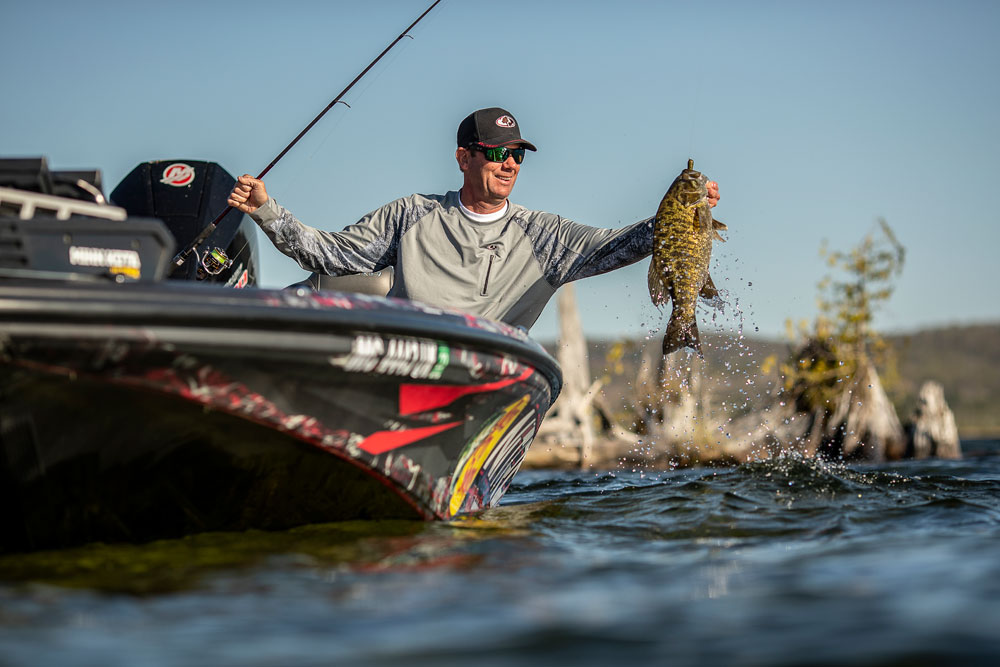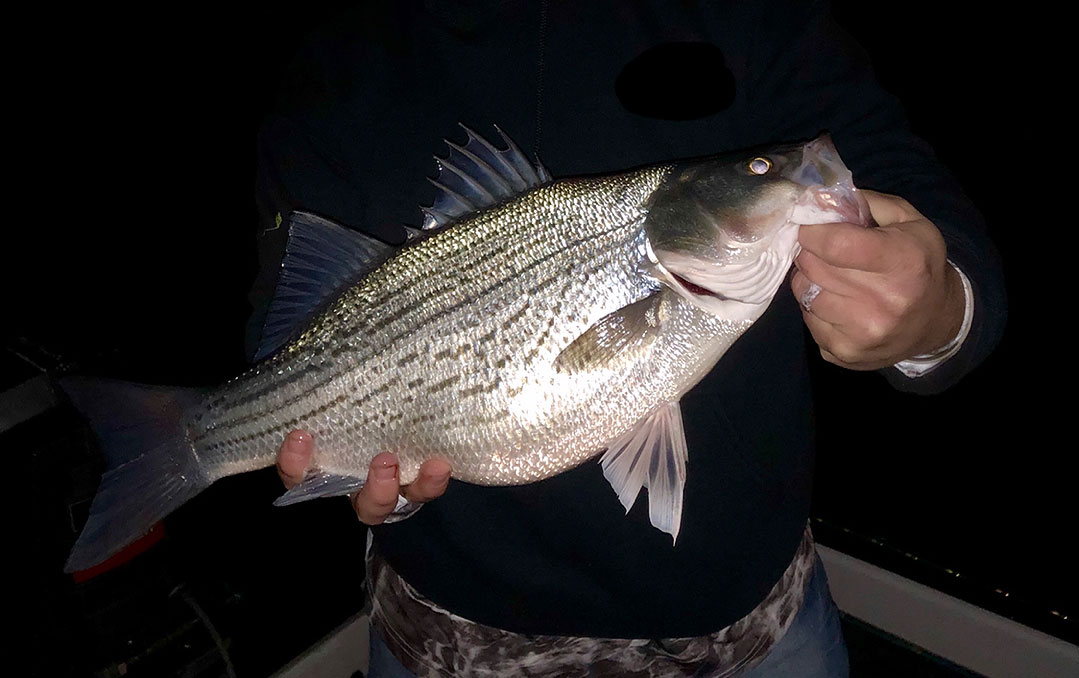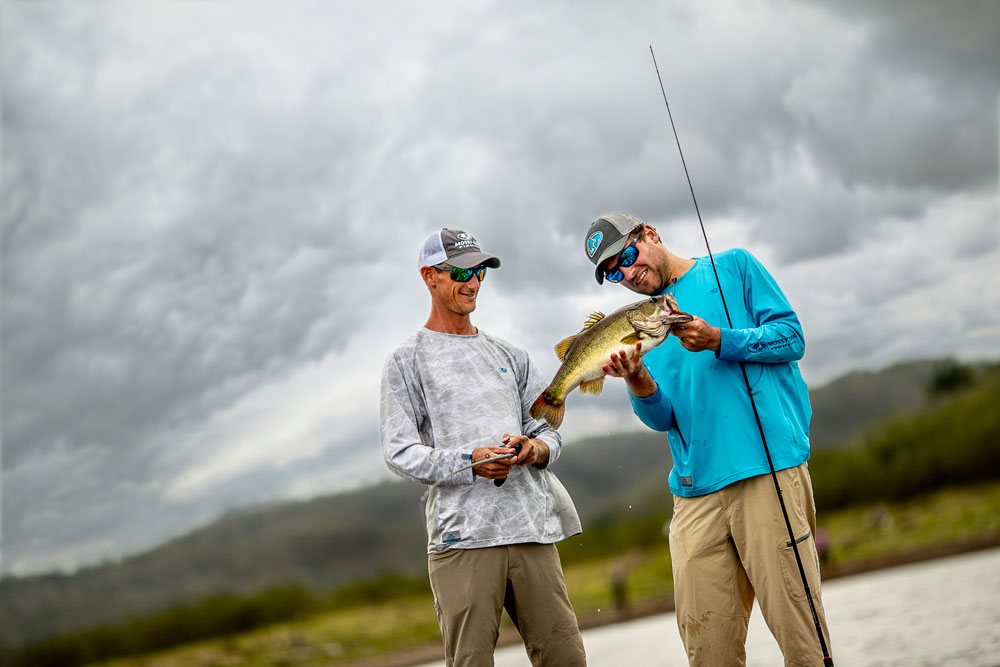When it comes to bass fishing, knowing what type of bass you’re going after informs your fishing tactics. While black bass are traditional game for all anglers, the newer wiper or hybrid bass are novel territory for some.
In this species 101 guide, learn about the different types of bass found in North America, including where they can be found, and helpful bass fishing tactics that bring in the big catch.

Types of Bass in North America
There are several types of bass in North America. The largest group of bass are the black bass, which includes largemouth and spotted, but there are also yellow bass and white bass. Below are the bass fish recognized in the U.S.
Black Bass
Black bass are the most well-known freshwater gamefish in the U.S. They have big appetites and provide a satisfying fight for anglers. There are several species of bass within the black bass category, including:
- Florida bass
- Guadalupe bass
- Smallmouth bass
- Alabama bass
- Shoal bass
- Redeye bass
- Spotted bass
- Suwannee bass
- Largemouth bass
Largemouth bass are the most popular species for anglers and are found in lakes and ponds in warm, murky water. Smallmouth bass are found in the same area, but they prefer colder currents. When going after smallmouth vs. largemouth bass, there is not much of a difference other than their preferred habitat and slight size difference.
The Guadalupe bass are only found in Texas waterways, while Suwanee bass are found in rivers in Florida and Georgia. Each species of black bass has its own habitat preference, but you can be sure you’ll find a type of bass to angle for if you fish in rivers or lakes.
Temperate Bass
Temperate bass are also known as sea bass or “true bass.” Temperate bass are medium to large and make for great trophy catches. Unlike black bass, temperate bass live in both saltwater and freshwater and are found mostly in the northeast and northern midwest parts of the U.S.
They include:
- White perch
- Striped bass
- White bass
- Yellow bass
Striped bass are found off the east coast of the United States and in the Atlantic Ocean and have been caught all along the riverways and tributaries inland as far south as Florida. As far as bass go, they are big and ferocious; some of the largest recorded sea-faring striped bass have reached 100 lbs. White bass are found in freshwater lakes and rivers. They like deep, clear water.
Wiper Bass
Wiper bass are a hybrid of the stripped base and white bass species. They are farmed in ponds and are well-suited to extreme temperatures. Wiper bass are aggressive feeders and feed on baitfish on the surface of the water. This makes them easy to see; however, they put up a fight when caught.

Helpful Fishing Tactics for Bass
Bass fishing is a multi-billion dollar industry. Ponds and lakes are stocked with bass and there are bass tournaments several times a year. Due to its popularity, there are a wide variety of bass- fishing techniques available for those who want to improve in the sport. Try these techniques next time you try summer or winter bass fishing.
1. Find the Right Habitat
The best way to angle for bass is to find where they hang out. Bass love to take cover to ambush their prey, so seek them out under wood, rocks and docks, under lily pads and in the grass. Most bass do not roam in the open water, so choosing a slightly hidden spot to put your lure gives you the best opportunity to catch a bass.
2. Embrace Versatility
To be a successful bass angler, don’t get stuck in the same fishing rut. Switch up the locations where you fish and consider making a trip to another location of the country, if possible, to try your hand at angling for a different type of bass. Mix it up by using different types of bait and use other tactics like the dropshot.
3. Use the Right Bait
The best way to land bass of all types is to match your lure to their prey. Most bass feed on small baitfish, depending on the season and fish population in the local habitat. Two favorites tend to be shad and minnow, so dropping a silvery swimbait or crankbait or a dropshot rig gives you the best chance of getting the big bass to strike.
4. Track the Weather
From drops in air pressure to temperature fluctuations, variations in weather have a drastic effect on fish behavior. Days with plenty of cloud cover can lull bass into a false sense of security, making them more likely to feed in vulnerable locations. You can capitalize on these behavioral changes by dropping moving baits, such as spinnerbaits and topwater plugs, guaranteed to draw as a strike from active schools of bass.
However, on sunny days, bass tend to be less active, preferring to wait for unsuspecting fish to approach them. Bottom bouncing baits, like a Texas-rigged soft plastic, flipped close by areas where bass shelter will give you the best chance of landing a big one.
Consult meteorological sites or angling weather apps, such as FishWeather and Fishing Forecast, to check for the weather conditions at your local fishing spot.
5. Track the Temperature
Along with the weather, it is helpful to track the temperature of the water. In summer, there are still places that remain cooler underwater, which affects the type of bass in the water and their behavior. Use a slow-moving bait in a water cooler and faster lures in warmer water. Be mindful of how the water temperature of your fishing location affects the feeding habits of the bass, and switch it up if one tactic doesn’t work.
6. Utilize Technology
Technology allows you to research locations before packing your gear and heading outside. Use fishing apps and map technologies to get a good idea of where the type of bass you want to catch are located and become familiar with the surrounding rivers and tributaries. In some instances, you are even able to pick out land features, such as creeks or coverings where bass may hide, which gives you an advantage over the old-fashioned show-up and hope for fish.

Happy Bass Fishing
Bass fishing is the most popular angling sport in the United States. Due to their large populations and aggressive feeding habits, bass fishing is great fun for anglers of all ages and skill levels.
Whether you go after largemouth bass in large ponds and lakes, smallmouth bass in rivers and ponds or try fishing off the east coast for the temperate bass variety, make sure to use the right bait, check out the weather outside and the temperature of the water and scope out the water terrain before your next trip.
For the best chance of bass-fishing success, you need the right fishing apparel. Visit the Mossy Oak store for all your high-performance fishing clothing to ensure you are cool and comfortable, so you can focus on landing the big one.






























